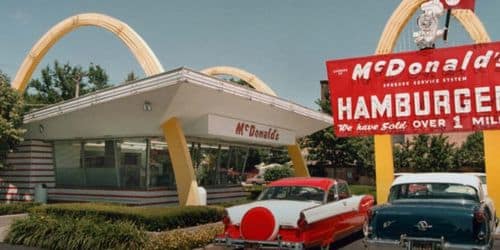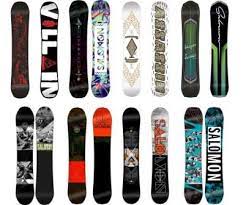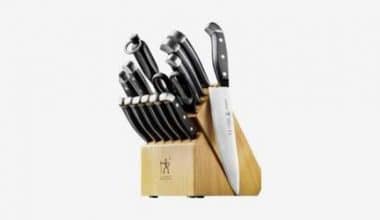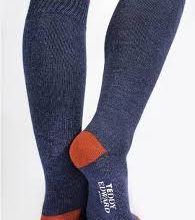It is one of the world’s most famous brands. The golden arches are right up there with Coca-Cola (KO), Mickey Mouse, and the New York Yankees. McDonald’s is arguably the most successful restaurant in the world, with over 30,000 locations in over 100 countries.
It all began with a hot dog stand. Let’s go through the history of McDonald’s, its logo, and building architecture and see how it contributed to the success of the franchise
The McDonald Brothers History: Their humble beginnings
Citrus squeezing was not the ambition of two brothers named McDonald from frosty Manchester, New Hampshire. They’d watched as their father was fired from the G after 42 years of service. P. Crafts shoe factory, was told he was too old to work. His working days were over in an instant.
The humiliation of his dismissal instilled in his children the importance of taking charge of their own futures in order to avoid such a fate.
In 1926, Maurice, known as Mac, led the way west, followed by Dick, seven years his junior, two of the first crop of speculators to blaze the trail that millions more would follow in the decades to come. Their ambition was to achieve fame, or at the very least fortune, in the burgeoning motion picture industry and become millionaires by the age of 50.
To make ends meet, the brothers ended up sweating for a living at Columbia Movie Studios, hauling sets and working lights on silent film sets during back-breaking shifts. Their weekly salaries of $25 were insufficient to allow them to live like kings, let alone secure their futures.
Unable to break into the more glamorous behind-the-scenes ranks of the industry, such as producing and directing, Dick and Mac scrimped and saved in order to participate in another, less glamorous part of the industry: screening them.
In 1930, they bought a theater 20 miles east of Los Angeles, in the heart of Glendora, a quaint, growing orange-belt town. Newsreels and double features made going to the movies an all-day event. To discourage people from bringing their own food to the movies, the brothers set up a snack bar in the lobby. It appeared to be a safe bet.
The Depression
The 750-seat Mission Theater was located just down the street from City Hall on the tree-lined Foothill Boulevard. The brothers renamed the venue with a positive new name. However, the Beacon struggled during the Depression years, and the brothers were perpetually in debt.
They even buried some silver in the backyard to protect themselves from bank closures. The only person who appeared to be making money was the owner of Wiley’s Root Beer Stand. So, after seven years in business, Dick and Mac sold the theater and switched industries from entertainment to food service in 1937.
The brothers briefly considered opening a new restaurant called the “Dimer,” where every menu item would cost ten cents, but dismissed the idea as too Depression-era. They were certain that the future would involve appealing to drivers.
McDonald’s predicted that the work week would soon be reduced to four days, leaving Americans with plenty of free time to drive around—and eat. They dismantled their stall and moved east to the growing desert city of San Bernandino or San Berdoo as the locals called it, a long-established trading hub 60 miles outside of Los Angeles.
What is McDonald’s an acronym for?
On a red background, the golden arches of the letter M represent the McDonald’s emblem. According to design expert and psychologist Louis Cheskin, the rounded M of the McDonald’s logo mimics the mammary glands of a mummy.
What category of eatery is McDonald’s?
McDonald’s, or McDonald’s Corporation, is an American fast-food chain that is one of the largest in the world and is famous for its hamburgers, particularly its Big Macs. The company’s headquarters are located in Chicago.
For what is McDonald’s renowned?
Our Diet. McDonald’s sells some of the most popular foods in the world, such as the Big Mac, Big n’ Tasty, Quarter Pounder with Cheese, Cheeseburger, French Fries, Egg McMuffin, Apple Pie, and Sundae. This is our worldwide and local claim to fame.
McDonald’s History: McDonald’s Barbeque
Their optimism about the future kept them going through rejection after rejection from banks, until they finally talked their way into a $5,000 loan from a lender who was impressed by the location they’d chosen in downtown San Berdoo at E Street and 14th.
Apart from their dreams, the brothers’ only collateral was their tired old octagonal juice stand, which they had spent $200 on a mover to cut in half and move to its new location. This time, the owners emblazoned their surname on the reincarnated business, followed by the featured menu item: “McDonald’s Barbeque.”
McDonald’s Barbeque, like other roadside restaurants of the time, delivered food directly to the customer’s car via a fleet of attractive young women known as carhops, so named because of their practice of jumping up on the car’s running board to claim a patron as their own. Dick and Mac, ever thrifty, dressed these ladies in usherette uniforms recycled from the Beacon, adding to the already theatrical flourish of service to your window.
McDonald’s survived the wartime depravity when creature comforts and pleasures were duly rationed. The armistice signaled the beginning of an era of carefree abandon that swept over even the most mundane aspects of life. Americans had banked both their money and their desire to have fun, and they were now making up for the lost time.
After the war, Henry Ford’s assembly lines resumed production of cars priced for the average consumer. By 1950, there were 40 million cars on the road. Fuel taxes enabled the construction of wide new thoroughfares that provided access to vast swaths of America and new opportunities for adventure.
Read Also: MERCEDES BENZ: The Untold Story of the World’s No. 1 Car Brand
All of this necessitated the expansion of services such as gas stations, restaurants, and motels. The journey became just as important as the destination. Eating meals away from home became not only socially acceptable but also a sign of carefree affluence. Eating a meal delivered directly to the window of your beloved new vehicle heightened the sense of freedom that car ownership provided.
Roads that were once densely forested were now dotted with quick-service restaurants. While a mound of ground beef was once thought to be a tasteless and suspect blob of glop, the hamburger has suddenly become de rigueur.
However, much to the chagrin of the family-oriented, these stands did not only serve food. Drive-ins became minefields of nefarious behavior, with loitering teenagers smoking and blasting the jukebox and engaging in sexual shenanigans in the parking lot with hired help. Employees would quit or fail to show up for work on a regular basis, leaving their employers in the lurch.
None of this had any effect on sales. A steady stream of customers kept a cast of 20 carhops busy, and the parking lot, with room for 125 vehicles, was full, making it the go-to spot in town for the younger set.
In the face of this success, Dick and Mac made the audacious, perhaps foolish, decision to take a step back and reassess, closing their doors for a period of time. Dick and Mac pondered how they could make hamburgers, fries, and shakes as quickly as possible. They wondered how they could streamline operations to maximize profit. How could they set themselves apart from the other drive-ins? How could they improve service?
Who owns McDonald’s?
The current corporation was founded on April 15, 1955 by franchising businessman Ray Kroc.
Why is McDonald’s so well-known?
McDonald’s current success can be ascribed in great part to its franchising model, consistency, and innovation. Their franchising model enabled them to experience quick expansion.
Which beef does McDonald’s use?
McDonald’s burgers are produced from 100 percent ground beef, shaped into hamburger patties, and then rapidly frozen at our suppliers to lock in a deliciously fresh flavor. In our restaurants, we add salt and pepper to our burgers before cooking them on the grill in order to bring out their delicious beef flavor.
Read Also: MOST EXPENSIVE RESTAURANT IN THE WORLD: Top 17+ Luxurious Restaurants 2022
In their search for answers, they were inspired by East Coasters named Levitt. This enterprising family used Ford’s Model T assembly-line logic to build homes on Long Island, New York, where housing was in short supply due to the rapidly expanding suburbs. The McDonald brothers aimed to replicate this prefab mentality in food preparation and serving: “Levittown on a bun.”
First, the brothers analyzed their sales receipts to determine the best sellers, and they reduced their menu from twenty-five items to the nine most popular items, eliminating the pricey and labor-intensive barbeque.
Dick posed as a freelance writer and went to Los Angeles to eavesdrop on candy industry trade secrets. He found inspiration in a hand-operated confectioner’s cone used to make peppermint patties. Dick enlisted the help of a mechanically inclined friend to create an automatic condiment dispenser that dispensed a precise squirt of ketchup or mustard with a button press. A mechanized press facilitated the rapid formation of beef patties.
To keep up with the demand for milkshakes, Dick and Mac purchased eight Multimixers, which allowed them to churn out frothy drinks five at a time. The surplus could be kept in the fridge and made available for the taking. Importantly, the customer was not permitted to request substitutions under the new business model. Hence, they slowed the pace.
They went to the tennis court behind their house in the middle of the night to finish the next phase of their makeover. They choreographed an assembly line of food preparation and delivery, using thick chunks of red chalk to plot the action, where workers could most efficiently grill the meats (40 patties in 110 seconds), fry the fries (900 servings per hour), and dispatch an entire meal to a hungry customer in just 20 seconds.
Read Also: NIKE LOGO: The Story Behind Great Branding!!!
A rare desert rainstorm struck after they’d called it quits, washing away the marks they’d charted. The stoic brothers plotted it all over again the next day, unimpressed.
This hamburger dance enabled Dick and Mac to address the costly personnel issue. Customers would have to get out of their cars and, gasp, walk to the window to order, replacing the alluring carhops. They could also look inside the “fishbowl” and marvel at the meticulous, efficient kitchen where their food was being prepared.
The new staff would be all men, dressed in neat, conservative paper hats and white uniforms that gave them an air of surgical cleanliness and precision. The brothers saw female employees as an unnecessary distraction.
The price list was the showpiece of the reincarnated operation. After accounting for lower labor costs, the brothers were able to charge crucial pennies less than the competition. A burger costs fifteen cents, a bag of fries costs ten cents, and a creamy, triple-thick milkshake costs twenty cents. Dick and Mac were betting that the combination of lower operating costs and a high volume of sales would result in a tidy profit.
It was universally despised by customers. Some people drove into the lot only to leave when no carhop appeared. Others bemoaned the loss of the previous, longer menu as well as the inability to customize. To make the restaurant look less deserted, the brothers had employees park in front of it. All for naught. The facelift was a colossal failure.
Read Also: RESTAURANT MARKETING: What You Should Know and Strategies
Four months later, for no apparent reason, a miraculous turnaround occurred. Cabbies arrived, followed by construction workers, then children, and soon lines of hungry customers crowded the counter, attracting more.
Sales were so good that the brothers commissioned a painting of a rising thermometer to hang in the front window, a nice visual to brag about. Dick said that when the number reached a million, the painter would add an explosion to the top.
Profits quickly soared to a hefty $100,000 per year, allowing them to indulge in their own personal automotive fantasy, upgrading to the most recent Cadillacs on the market—three of them, one for Mac’s wife. (Dick had not yet married.)
Hamburger lovers appeared to be willing to sacrifice variety for speed and price. The food’s quality was not the main attraction. Perhaps the exception was the brothers’ fries, which were a model of crisp freshness.
Mac had become a spud wizard, using chemistry principles and painstaking trial and error to perfect a recipe. The magic step involved drying Idaho russets in the desert air to break down the sugar content, which was an important but time-consuming step. Patience was as virtue as precision: improper blanching or hastening the process would result in greasy, limp potatoes, the kind fried up by the competition. It was the one area of McDonald’s recast formula that was slow and deliberate where required and permitted ingredients were.
Read Also: OPENING A RESTAURANT: Steps, Cost, and Guide
Aside from the long lines, the brothers had another indication that they were dealing with a hit. Impostors came to observe the operational ballet on display behind the store’s glass windows. When these imitators pressed Dick and Mac for information on what they couldn’t see, Dick and Mac cheerfully shared trade secrets. They eventually realized they could charge for their formula and make some extra money.
In 1952, a few months after their shortening provider, Primex, published an article in the trade journal American Restaurant praising McDonald’s prolific French fry operation, the brothers ran their own advertisement. “The Most Important Sixty Seconds in Your Entire Life,” they promised readers.
The centerpiece of the advertisement was a glowing image of their distinctive hexagonal structure. Their “revolutionary development in the restaurant industry” was now for sale to anyone who was interested.
A cover story echoed the hype, touting McDonald’s annual sales of “one million hamburgers and 160 tons of French fries” and revealing a whopping $277,000 gross annual take. That sealed the deal. San Berdoo was transformed into Oz by aspiring hamburger barons.
Instead of simply paying a visit and stealing the idea, the more honest among the group paid a $950 franchise fee for the formula. First in line was Neil Fox, an oil executive from Phoenix whose family thought he was crazy for getting involved in this sleazy hamburger business.
Read Also: RESTAURANT MANAGEMENT SYSTEM: Guide to Effective Restaurant Management
Dick and Mac thought Fox was crazy, too, for wanting to use their name instead of his own on the stand he planned to build. They claimed that the term “McDonald’s” had no meaning outside of San Bernardino. Fox told the brothers that he thought their surname was “lucky.”
Aside from the name, Fox received an operating manual, a counterman on loan for a week to show him the ropes, and a hot-off-the-press architectural blueprint from which to build a specially designed red-and-white tiled restaurant—suitably eye-catching and accommodating of the sacred automobile.
Hundreds of questions poured in. Carnation, a dairy supplier, was eager to bring McDonald’s and its winning formula into its corporate fold. In order to increase ice cream sales, the company’s executives proposed replicating McDonald’s across the country.
The brothers considered the alliance but ultimately declined; they were content with the status quo and did not want their business and personal lives to be engulfed by a large bureaucracy. The extra effort did not appear to be worth the potential payoff.
“More places, more problems,” Mac grumbled. “We’re going to be on the road all the time, in motels, looking for locations, looking for managers,” he said. It was easier to just sell the manual and blueprints and pocket the $950 fee.
One day, among the steady stream of curious onlookers on E Street, was a compact, well-dressed, hard-up 52-year-old Chicago salesman looking for a lucky break. Ray Kroc was his name.
McDonald’s History: Ray Kroc Jr.
Ray Kroc, a native Chicagoan, dropped out of high school after his sophomore year to join the Red Cross Ambulance Corps during World War One. Ray returned home to work as a musician and later sold paper cups after the war ended before his unit was sent overseas. He became Multimixer’s exclusive distributor in 1939. (a milkshake mixing machine). In 1954, he paid a visit to the McDonald brothers, which led to him becoming their franchise agent. Kroc opened the first McDonald’s east of the Mississippi River in 1955.
McDonald’s History: Developing the brand from franchisees to Big Macs
Recognizing the importance of franchisees to the company’s success, Kroc established stringent guidelines for how each McDonald’s should be run, from food preparation to cleaning.
To ensure the standardized operation of the outlets, he established (1961) a program to train franchisees, later known as Hamburger University.
Furthermore, he eventually changed the restaurant format, adding counter staff to take orders, and in 1975, a McDonald’s in Arizona opened the chain’s first drive-through window, a feature that quickly became ubiquitous.
McDonald’s History: Ronald McDonald
During this time, McDonald’s also introduced three features that would define its brand and increase public awareness. First, in 1963, the company’s public face, a clown named Ronald McDonald, was introduced; however, criticism over marketing to children and a growing negative perception of clowns resulted in the company largely sidelining the character in the early twenty-first century.
Perhaps the most notable addition was when McDonald’s added the Big Mac to its national menu in 1968; the iconic hamburger went on to become the company’s top-selling item after french fries.
Furthermore, the chain refined its logo during the 1960s, eventually debuting the famous double-arch M design, which became its enduring symbol and one of the world’s most famous logos; it was inspired by the tall yellow arches that had dominated earlier McDonald’s restaurant rooftops.
The chain expanded both domestically and internationally. McDonald’s first location outside the United States opened in 1967 in Richmond, British Columbia, Canada. By the early twenty-first century, there were approximately 34,000 outlets in over 115 countries and territories. In the 1990s, growth was so rapid that it was said that a new McDonald’s opened somewhere in the world every five hours. It quickly became the most popular family restaurant, focusing on affordable food, fun, and flavors that appealed to both children and adults.
These modifications aided McDonald’s expansion. In less than ten years after Kroc became the sole owner of McDonald’s, the chain’s outlet count surpassed 1,000. The company’s stock began trading publicly in 1965, boosted by these figures.
McDonald’s History: Marrakech
McDonald’s expanded its menu over time, introducing Filet-O-Fish sandwiches in 1965, Quarter Pounders in 1973, Egg McMuffins in 1975, Happy Meals in 1979, and Chicken McNuggets in 1982. (1983). Furthermore, restaurants in other countries adapted their menus to appeal to local customs and tastes.
In the late twentieth century, McDonald’s expanded beyond the hamburger business by acquiring Chipotle Mexican Grill (1998), Donatos Pizza (1999), Boston Market (2000) in the United States, and Aroma Cafe (1999) and interest in Pret A Manger (2001) in the United Kingdom. By late 2008, however, McDonald’s no longer owned or had a stake in any of those companies, instead focusing on its own brand.
McDonald’s History: Challenges and Criticism
McDonald’s success drew increased criticism, much of which focused on its perceived association with a global increase in obesity. Several lawsuits were filed against the company in the early 2000s in the United States, alleging that its food caused health problems.
Despite the fact that none of the plaintiffs were successful, a number of states passed legislation prohibiting obesity lawsuits against fast-food corporations. McDonald’s also faced criticism following the release of the popular documentary Super Size Me (2004), in which the filmmaker saw his health deteriorate while eating only McDonald’s foods.
McDonald’s responded to the criticism by adding healthy items to its menu and developing a vegan “hamburger” with variations known as McVegan, P.L.T., and McPlant. The company released its first plant-based hamburger in 2017, though it was only available in a few markets. It began testing another vegan hamburger two years later.
Furthermore, in 2018, McDonald’s announced that it would no longer use preservatives in the majority of its hamburgers. During this time, the company also eliminated supersized portions, and its restaurants in the United States and Canada stopped using trans fat in a variety of items. However, such measures did little to alleviate health concerns.
McDonald’s, as one of the world’s largest private employers, faced numerous calls to raise wages. McJob was added to the Merriam-Webster dictionary to mean “low-paying job,” and the company was chastised for its environmental impact, particularly its contributions to greenhouse gas emissions.
McDonald’s launched initiatives to reduce emissions at its restaurants and in the beef production of its suppliers in the early twenty-first century. Furthermore, McDonald’s packaging was a source of concern, and during this time, the company launched a program to transition to renewable or recycled bags, utensils, and other items.
McDonald History: Charity Works
McDonald’s was involved in a number of charitable endeavors. It collaborated with Philadelphia Eagles football player Fred Hill, whose daughter was diagnosed with leukemia, to establish the Ronald McDonald House in Philadelphia in 1974.
Families were able to live near the hospital where their children were receiving treatment thanks to the residence. Around the world, more than 360 such houses existed by the early twenty-first century.
Furthermore, Ronald McDonald House Charities (founded in 1987) contributes to a variety of other causes. McDonald’s also launched new initiatives, such as a college scholarship program for Hispanic students.
McDonald’s History Timeline
1940
Dick and Mac McDonald open the first McDonald’s Bar-B-Q restaurant in San Bernardino, California, on Fourteenth and E streets. It’s your typical drive-in with a large menu and car hop service.
1948
The McDonald brothers closed their restaurant for three months to make changes. It will reopen as a self-service drive-in restaurant in December. There are only nine items on the menu: a hamburger, a cheeseburger, soft drinks, milk, coffee, potato chips, and a slice of pie. The 15-cent hamburger is a menu staple.
1949
French fries replace potato chips, and Triple Thick Milkshakes make their debut on the McDonald’s menu.
1954
Ray Kroc, a Multimixer salesman, visits McDonald’s in San Bernardino with the intention of selling the brothers more Multimixers. The operation fascinates Kroc, who is 52 years old. The brothers inform him that they are looking for a nationwide franchising agent. He has an epiphany and decides that his future is in hamburgers.
1955
On April 15, Kroc opens his first McDonald’s in Des Plaines, Illinois. Stanley Meston designed the eye-catching red and white tiled building with the Golden Arches in 1953. The first-day sales total $366.12.
1956
Future McDonald’s Chairman Fred Turner is hired as a counterman for the Des Plaines McDonald’s. He would soon become the head of McDonald’s Operations, establishing standards for quality, service, and cleanliness that are still in place today.
1961
Hamburger University opens in the basement of a McDonald’s restaurant in Elk Grove Village, Illinois. Bachelor of Hamburgerology degrees is awarded to graduates.
1965
The first item added to the national menu was the Filet-O-Fish sandwich. Created by Lou Groen, a McDonald’s Cincinnati franchisee, to help increase volume in the predominantly Roman Catholic neighborhood in which his store was located.
1968
The Big Mac, created by Pittsburgh owner/operator Jim Delligatti, is added to the national menu.
1973
The Quarter Pounder and Quarter Pounder with Cheese are now available.
1974
In Philadelphia, Pennsylvania, the first Ronald McDonald House opens. In 1973, Fred Hill, a Philadelphia Eagles football player, saw the need for such a facility at Children’s Hospital in Philadelphia, where his child was being treated for leukemia. Hill’s dilemma resulted in the establishment of the first Ronald McDonald House.
1975
The Egg McMuffin, invented by Herb Peterson of Santa Barbara, California, has been added to the national menu.
1983
Chicken McNuggets are now available in all domestic U.S. restaurants.
1984
Ray Kroc, the company’s founder and senior chairman of the board, died on January 14.
1990
The first McDonald’s restaurant in Moscow opens on January 31. On the first day, more than 30,000 customers were served at the Pushkin Square location.
1993
The first McCafé in the world opens in Melbourne, Victoria, Australia.
1995
McFlurry Desserts, created by Ron McLellan, O/O Canada, are added to the menu of McDonald’s Canada.
2002
On April 15, 2002, McDonald’s released its first Social Responsibility Report.
2003
On September 2, McDonald’s first global advertising campaign, “I’m lovin’ it,” debuts in Munich, Germany.
2015
McDonald’s USA has introduced All Day Breakfast.
2017
On July 26, Global McDelivery Day is observed to commemorate the global launch of McDelivery with UberEATS.
2020
McDonald’s opens its first net zero-design restaurant at Walt Disney World Resort, which generates enough renewable energy on-site to cover 100% of its net annual energy needs.
McDonald’s Construction: Visit McDonald’s Restaurants

Dick and Mac McDonald relocated to California in search of opportunities that they felt were unavailable in New England. After failing in the film industry, they found success in operating drive-in restaurants.
They took a risk in 1948 by streamlining their operations and introducing the Speedee Service System, which featured 15-cent hamburgers. The restaurant’s success prompted the brothers to start franchising their concept, with nine of them becoming operational restaurants.
The colors red and white
The McDonald brothers insisted that their architect create an eye-catching structure that highlighted their Speedee Service System. The “Red and White” design by architect Stanley Meson did not disappoint. Dick McDonald added arches to the building because he thought the roof line was too flat. This building design was used from 1953 until the late 1960s when it was replaced by the Mansard Roof design.
The “Golden Arches” were created by incorporating yellow neon into them. Downey, California has the oldest McDonald’s Red and White (opened in 1953) that is still in operation today.
Early designs for the iconic McDonald’s Red and White restaurant, complete with Speedee road sign.
The Mansard Roof
In 1969, McDonald’s debuted the new Mansard Roof Design in Matteson, Illinois. Many franchisees initially remodeled their existing Red and White buildings to reflect the new design. During the 1970s, McDonaldland Parks (Play Places) and the Drive-Thru were added to the restaurant. Several changes were made to the exterior of the Mansard over the years.
A traditional Speedee road sign is featured on the adapted Mansard Roof of a remodeled Red & White building from 1970.
McDonald’s in Fresno, California, depicting the transition from the Red and White to its remodel, culminating in the 1973 opening of the Mansard design.
Todays Designs
McDonald’s restaurants have designs that incorporate existing architecture as well as other distinctive features. The architecture is constantly evolving to meet the expectations of our customers.
McDonald’s Logo: History and significance
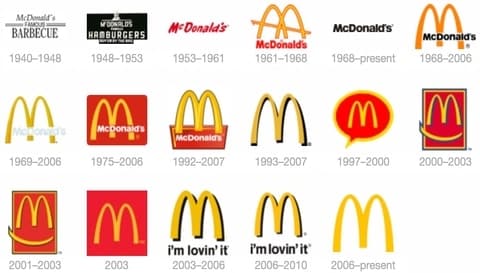
The story of the world’s most famous fast-food restaurant chain begins in 1937 when Patrick McDonald opened “The Airdome,” the family’s first restaurant. Three years later, his sons changed the name to “McDonald’s Famous Barbecue.”
The company’s current title was only adopted in 1953, and the design prototype for the iconic Golden Arches logo was created in the 1960s. Since then, the fast-food legend’s visual identity has remained relatively consistent, and it has evolved into one of the most brilliant examples of perfect branding in modern history.
McDonald’s Logo: 1940 – 1948
The restaurant’s first logo was a black wordmark set in three levels and executed in three different styles.
The upper portion featured the “McDonald’s” inscription in an elegant and traditional italicized serif font. The word “Famous” was written in all capitals in sans-serif and placed in the center, with two parallel horizontal lines coming out of it to the right and left.
The “Barbecue” inscription, the largest and boldest part of the entire logo, was executed in a strict and solid serif font and was located on the lower level of the logo, being its main part.
McDonald’s Logo: 1948 – 1953
The concept of barbecue was replaced by hamburgers, which were becoming increasingly popular in the United States. In 1948, the restaurant’s name was changed, and the logo was redesigned.
It was now made up of a white “MacDonald’s Famous Hamburgers” nameplate on a black background, with a small white image of the Chef smiling and friendly. The inscription was done in a single style, with a modern sans-serif typeface. This logo was only in use for 5 years.
McDonald’s Logo: 1953 – 1968
The company was eventually renamed McDonald’s, and this is where it all began. The logo was still far from what we know today, but the red color appeared in the color palette, pointing the brand in the right direction.
The red italicized wordmark was created using a custom sans-serif typeface with thick sleek lines. It was a memorable and recognizable logo that was used by the company for 15 years.
McDonald’s Logo: 1961 – 1968
Stanley Meston creates the world-famous emblem in 1961. The architecture of the first company’s restaurants, specifically their roofs, inspired the iconic Golden Arches logo. This is why the first version of the logo has a diagonal line running through the arches.
The yellow emblem has a thin red outline, and the red wordmark is placed beneath it. The new inscription was created in a bold and simple sans-serif typeface, emphasizing the emblem.
McDonald’s Logo: 1968 – Today
In 1968, the logo was simplified. The diagonal line was removed, and the inner ends of the two arched were shortened to resemble the letter “M.” The color scheme was updated to include yellow for the emblem and black for the wordmark, which was placed over the “M” on its lower part.
The nameplate’s typeface was also refined slightly, making the letters more solid and visible.
This McDonald’s logo is still used on some of the company’s products and international restaurants today.
McDonald’s Logo: 1975 – Today
The new visual identity was introduced in 1975. The wordmark was placed inside a red rectangle with rounded corners. The lettering was changed from black to white, making it appear friendlier and more welcoming.
This insignia is probably the most recognizable of all the fast-food legend logos, and it is still used by the company, as it is instantly recognizable around the world and evokes a sense of joy, happiness, and passion.
McDonald’s Logo: 1993 – 2010
The 1993 version featured a simple yellow “M” with a black shadow, no lettering or framing, just a minimalist emblem that was initially used only in the United States, but later became international and stayed with the company for nearly two decades.
McDonald’s Logo: 2003 – Today
When another version of the logo was designed in the early 2000s, the same minimalist approach was used. The flat yellow “M” was centered within a red square with rounded corners.
It wasn’t used much at first, but after a slight change in 2018, the brand began to use it extensively. In addition to two other versions.
McDonald’s Logo: 2006 – Today
The flat yellow design for the brand was created in 2006. The most basic of the versions, it is now widely used by the company for both domestic and international markets. A neat “M” made up of two arches is executed in yellow and placed on white. There is no outline, lettering, or anything else. It appears modern and stylish, reflecting the company’s heritage and making people around the world smile and recall happy memories.
McDonald’s Logo: 2018 – Today
The 2018 design is the same yellow emblem that has been used for a long time, but it is now housed within a red square with rounded corners.
McDonald’s Logo: Font
The current McDonald’s logo incorporates a custom sans-serif font. There isn’t a single capitalized letter, and even “I” is written in lowercase.
McDonald’s Logo: Color

The emblem is available in two color variations: black and yellow/red. When a colorful representation is possible, the yellow/red one is used, while the black one is used in black-and-white visual contexts.
Who Made the McDonald’s logo?
Jim Schindler created the McDonald’s logo in 1962. He was brought in to give the logo a more corporate appearance. He drew two arches, combined them, and created one of the world’s most recognizable brands.
Why Is the McDonald’s Logo So Successful?
The golden arches are bold and powerful, and they are impossible to miss when passing by a McDonald’s. The big yellow arches give the impression that McDonald’s is a fast-food behemoth that can be trusted.
What Is the Name of the McDonald’s Logo?
The McDonald’s logo is commonly referred to as “The Golden Arches.” Customers were told to “look for the golden arches” in an early McDonald’s advertisement.
What Is McDonald’s Slogan?
McDonald’s slogan is “I’m Lovin It.” It’s one of the most well-known slogans in the world. The slogan was created by rapper Pusha T.
Conclusion
Fast-food innovation isn’t rocket science, but it does require a certain kind of practical genius. McDonald’s has managed to extract ever-increasing sales and profits from the American fast food industry, which was widely regarded as oversaturated in the 1980s.
Think about how different fast food would be without McDonald’s constant innovations the next time you stop in for a hamburger or a latte.
Related Articles
- MOST VALUABLE BRANDS 2023
- Value Chain Analysis: Steps to Value Chain Analysis
- FAST FOOD FRANCHISE: Costs & The Best 2023 Options to Own (Updated)
- Psychographic Segmentation: Advantages, tools (+ practical examples)
- NEW YORK YANKEES LOGO: Meaning, Font and History
